Basic chess rules are essential if you want to learn chess. That’s why we are explaining these chess rules in an easy-to-understand way. From the initial board setup to the movement of every piece, we will explain everything in this chess rules section.
What’s the Goal of Chess
The ultimate aim in the chess game is delivering a checkmate – trapping your opponent´s king. The term checkmate is an alteration of the Persian phrase “Shah Mat”, meaning literally, “the King is ambushed”, and not “the King is dead”, that is a common misconception.
General Chess Rules
White is always first to move and players take turns alternately moving one piece at a time. Movement is required. Each type of piece has its own method of movement. A piece may be moved to another position or may capture an opponent´s piece, replacing on its square (en passant being the only exception). With the exception of the knight, a piece may not move over or through any of the other pieces.
Stalemate
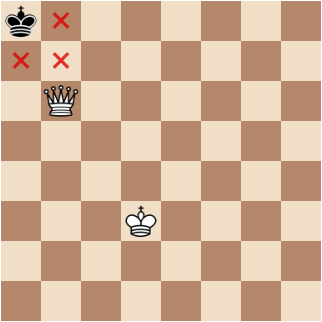
If a player´s turn is to move, he is not in check but has no legal moves, this situation is called “Stalemate” and it ends the game in a draw.
Check

When a king is threatened with capture (but can protect himself or escape), it´s called check. If a king is in check, then the player must make a move that eliminates the threat of capture and cannot leave the king in check.
Checkmate
Checkmate happens when a king is placed in check and there is no legal move to escape. Checkmate ends the game and the side whose king was checkmated loses. Chess for kids would be a great option to help the kid enhance his thinking capability with the chess strategies involved. Visit our affiliate chess online lessons website for scheduling an evaluation session with one of our experienced chess coaches.
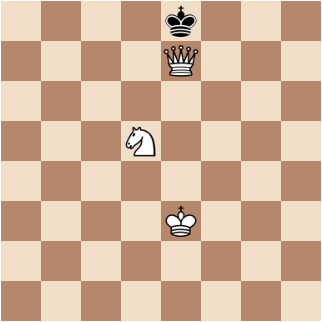
The Initial Position Setup
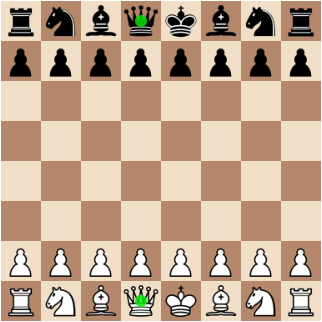
The chessboard is made up of eight rows and eight columns for a total of 64 squares of alternating colors. Each square of the chessboard is identified with a unique pair of a letter and a number. The vertical files are labeled a through h, from White´s left (i.e. the queenside) to White´s right. Similarly, the horizontal ranks are numbered from 1 to 8, starting from the one nearest White´s side of the board. Each square of the board, then, is uniquely identified by its file letter and rank number. In the initial position setup, the light queen is positioned on a light square and the dark queen is situated on a dark square. The diagram below shows how the pieces should be initially situated.
How the Various Chess Pieces Move
King

King can move exactly one square horizontally, vertically, or diagonally. At most once in every game, each king is allowed to make a special move, known as castling.
Queen

Queen can move any number of vacant squares diagonally, horizontally, or vertically.
Rook
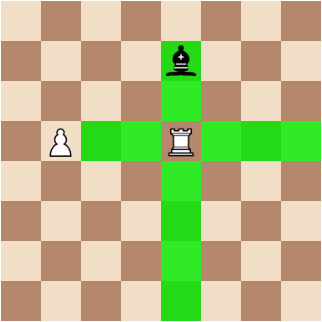
Rook can move any number of vacant squares vertically or horizontally. It also is moved while castling
Bishop
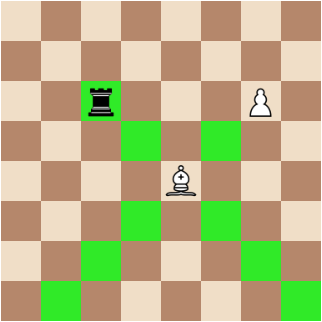
Bishop can move any number of vacant squares in any diagonal direction.
Knight

Knight can move one square along any rank or file and then at an angle. The knight´s movement can also be viewed as an “L” or “7″ laid out at any horizontal or vertical angle.
Pawn

Pawns can move forward one square, if that square is unoccupied. If it has not yet moved, the pawn has the option of moving two squares forward provided both squares in front of the pawn are unoccupied. A pawn cannot move backward. Pawns are the only pieces that capture differently from how they move. They can capture an enemy piece on either of the two spaces adjacent to the space in front of them (i.e., the two squares diagonally in front of them) but cannot move to these spaces if they are vacant. The pawn is also involved in the two special moves en passant and promotion.
Special Rules of Chess
Castling
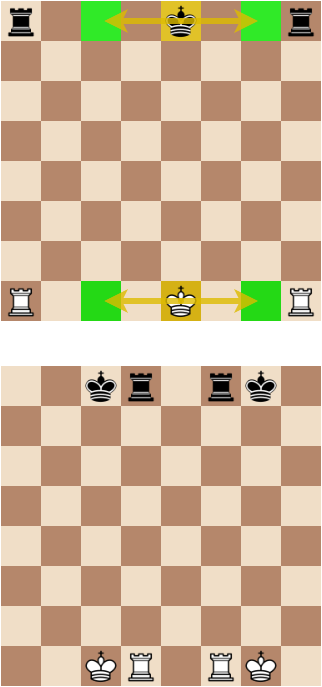
Castling is the only time in the chess game when more than one piece moves during a turn. This chess move has been invented in the 1500s to help speed up the game and improve the balance of the offense and defense. During the castling, the king moves two squares towards the rook he intends to castle with, and the rook moves to the square through which the king passed. Castling is only permissible if all of the following conditions hold:
- Neither king nor rook involved in castling may have moved from the original position;
- There must be no pieces between the king and the rook;
The king may not currently be in check, nor may the king pass through or end up in a square that is under attack by an enemy piece (though the rook is permitted to be under attack and to pass over an attacked square)
En Passant

En Passant may only occur when a pawn is moved two squares on its initial movement. When this happens, the opposing player has the option to take the moved pawn “en passant” as if it had only moved one square. This option, though, only stays open for one move. The En Passant move was developed after pawns were allowed to move more than one square on their initial move. The idea behind this rule was to retain restrictions imposed by slow movement, while at the same time speeding up the game.
Pawn promotion

If a pawn reaches the opponent´s edge of the table, it will be promoted – the pawn may be converted to a queen, rook, bishop or knight, as the player desires. The choice is not limited to previously captured pieces. Thus its´ theoretically possible having up to nine queens or up to ten rooks, bishops, or knights if all pawns are promoted.
Free Trial Chess Lesson
IchessU provides live online chess lessons for kids and for adults, with specialized chess courses from beginners to experienced advanced chess players. The chess lessons are available in groups and as private lessons. IchessU coaches have taught the game to thousands of children and adults all over the world, many of whom have gone on to win major tournaments. IchessU chess school is your best online resource to learn chess, improve your chess game or just have fun!
Thanks for visiting our chess rules section. We offer online chess lessons given live by our experienced chess coaches to help you to learn to play chess. You would love your classes in our chess community.
When Were the Rules of Chess Established
Chess is believed to have been invented 1500 years ago in India. The game has changed only slightly since then with the advent of the queen in the 15th century and some minor movement adjustments in the 1800s.
How to Implement the Rules of Chess Effectively
Beginners often feel overwhelmed when they play chess on a serious level. They sometimes feel intimidated by their opponents. This happens due to the lack of confidence the chess players do not have during the beginning phase. This is where the online chess coaching tutorial can be used for learning chess from the top mentors. Chess experts suggest learning the best moves for beginner’s chess to gain control and confidence.
Tips for Your First Steps in Chess
1. Control the central part of the board
If you observe very closely, you will find that all the master chess players always maintain control on the central part of the checkered board. It is the place where all the pieces will eventually move and occupy positions. If you lose the central part, you will not be able to move your pieces and the opponent will win. This is the first rule for beginner’s chess.
2. Developing pieces faster
Your prime aim is to develop the pieces with their fullest might as fast as possible. Try avoiding playing the same piece over and over again. You are actually missing the chance to ripen your chess pieces on the central part of the board. The more pieces you develop, the better chances you will get to control the board and to defeat the opponent.
3. Keep the queen safe for the time being
Do not play the queen in the middle board immaturely. The opponent will take this advantage and will sacrifice his less-powerful pieces to kill your queen and win the game. Concentrate on the other pieces and use the queen later as strength.
Training Tips
Playing chess will never be old when you have the right platform and partner. You need to learn exciting moves and give a twist to your game plan. This will surely make every board you play more fascinating and exciting. If you are a newbie, learn from the best platform regarding how to play chess for beginners.
Chess is a game of two minds. Reading the mind of the opponent and thinking of what his next move will be is no less than an adrenaline rush. In fact, your calculations related to every single move will give you satisfaction when they come true. Here is how you can make yourself an outstanding chess player someday. Learn how to play chess for beginners and give it a good start:
- Learn how to set up the board
Follow the international rules and earn how to set up a chessboard. Find out where the pieces go and how they move. This is the first step of learning chess. Practice and remember the moves of all pieces and kick-start a fascinating journey in the chess land.
- Think of it as an army
Whether you like to start with black or white, consider the chess pieces as your army. Learn how every soldier, the queen, and the king move on the chessboard. This is the way to start and learn how to play chess for beginners.
- Practice online
You will find a plethora of software and digital platforms where you can play chess and practice. Don’t get disheartened if you lose. It is a part of the learning process.
Start Learning Openings
It is essential to know how to learn chess openings effectively because your initial moves will determine your game’s direction. If you are playing against an excellent opponent, one wrong opening move can mean losing.
There are many ways to learn opening strategies. One common technique is to memorize the moves simply. However, this is boring for many players and according to experts, it can be counterproductive because there’s always the danger of mixing things up.
So, how do you learn a chess opening the right way? Here are some tips for you.
Choose a chess opening that looks interesting
You must find a chess opening that piques your interest not something that looks boring to you from the start. This way, you will be driven to understand that chess opening more and enjoy the process of learning. You can begin with the easiest openings or with those that are used by grandmaster-level players. You may also opt for tactical and highly aggressive openings that involve lots of attacking. If you are the quiet type, then go for more those that have slow buildup.
Focus on the core concepts of the opening
If you want to know how to learn chess openings, then shift your focus. Understand the basic ideas and goals of an opening instead of memorizing every nuance and variation. These technical details will follow as you develop a firm grasp of the fundamentals.
Learn the main lines for both sides
The mainline refers to the first eight to ten moves of the opening. These are the only things that you must memorize, and these will be enough to get started.
Look for games where your chosen chess opening is used
Search for games played by a very strong chess player who uses the variation of your choice and then analyzes every move. For example, if you want to learn Petroff, then the best games to watch are those of Vladimir Kramnik because he is the strongest contender is an expert in this opening.
How Kids Should Practice With the Rules of Chess
Children today are highly influenced by the virtual world. Using this fascination productively, by enrolling them in chess classes can help make learning fun. The chess rules for kids are similar to that of the adults. However, if they are beginners, and are here to learn the rudiments of the game, then the moves can be modified to suit their requirements.
The best way to ensure the player learns the chess rules for the kids is to check out the videos and expert tutorials online. Many virtual chess coaching classes have videos and tutorials exclusively for children. This beginner level video has separate moves and strategies according to the level of understanding of the player.
As a beginner, the kids might first want to understand the significance of the pieces on the board, the squares, and what they represent. The kids need to:
- Acquire a deep knowledge about the board and what they imply,
- Understand how each piece is exclusive and their moves vary
- Learn why white and black moves are different
- To study what happens at the end of the game and how some pieces acquire more significance at the end and much more.
Also, the kids can study the beginner’s game played by their seniors, and understand the significance of an opening or how to get a perfect closure at the end.
The best way to go about this and teach chess rules to kids is to enroll them in an online chess tutorial. An expert trainer from the virtual classes can guide them slowly towards the basics of the game and make them watch a beginner’s level game. The benefits of these online coaching classes are that they offer different packages and time slots. They are also cost-effective and efficient too, making it a worthwhile endeavor to pursue and keep your kids away from the usual video games.
Alternative Rules in Playing Chess
Chess has certain rules and standards that players must follow to ensure a smooth gameplay that makes sense. However, some chess games can be played using alternative rules that may involve removing certain pieces or adding more pieces, and various time limits. Knowing these alternate rules can help you become a more versatile player while expanding your knowledge and ability. It can also make playing chess with your friends more fun.
Odd chess is one of the alternate ways to play chess. It lets unevenly matched players enjoy a fair game. Hence, it does not matter if you are playing an amateur player with a master and vice-versa. In odd chess, the more experienced or skilled player receives a handicap, which can vary from minimal (i.e. the less skilled player going first) to extreme (i.e. experienced player eliminates his pieces in the queen’s side). Some players add other chess rules. For instance, the strong player delivers mate on a particular square or piece.
Los Alamos is another alternate version of chess, and it is played on a six by six square board without the bishops. This type of chess game was invented for early computers, back when they lacked computing power for a full game.
Capablanca chess is a game that is played on a 10 by 10 or 10 by eight board with additional pieces, such as an archbishop that can move like a knight and a bishop, and a chancellor that can move like a knight and rook.
Blitz chess is a form of orthodox chess but considered a variant due to its rule, where you are allowed to play at different time limits (usually five minutes for every game). Some orthodox chess games may require you to be blindfolded. It can be a test of how much you know the board and the pieces.